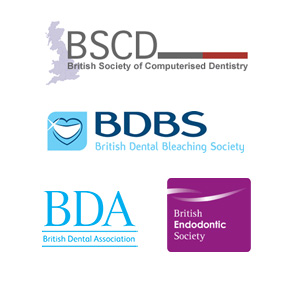Elizabeth Hoy
BDS, MJDF RCS(Eng), MClinDent Endo, MEndo RCS(Ed)
Treatments provided
- Root canal treatment and re-treatment
- Endodontic surgery
- Diagnosis and treatment of orofacial pain
- Management and follow up of traumatic dental injuries
- Pulp therapy and regeneration
- Removal of posts and broken instruments
- Management of perforations
- Internal/external tooth whitening
Information for patients and referring dentists
Fee Guide
- Consultation£110
- Incisor/canine root canal treatment from £950
- Premolar root canal treatment from £950
- Molar root canal treatment from £950
- Endodontic surgery from £950
- Root canal re-treatment +£100
- Post removal +£100
- Broken instrument removal +£100
Online form for patient self-referrals
Online form for referring dentists
Download & Print Referral Form
FAQs
What is endodontics?
Inside the tooth, beneath the hard enamel and dentine, lies the pulp. The pulp is soft tissue and contains blood vessels, nerves, connective tissue and other specialized cells. The pulp is responsible for forming the tooth initially and defending the tooth throughout life.
Endodontics is the branch of dentistry which is concerned with maintaining the health of the pulp, and managing diseases of the pulp and surrounding tissues.
What happens during root canal treatment?
If the pulp of the tooth becomes infected, root canal treatment can be carried out to resolve the infection and permit long-term survival of the tooth.
Bacteria can gain access to the pulp as a result of caries (tooth decay), cracks, following trauma, or around the margins of fillings and crowns. In root canal treatment the infected pulp is removed and inside the tooth is disinfected, filled and sealed. The tooth is then restored with a crown or a filling.
Is it painful?
With the use of local anesthetics and modern techniques, root canal treatment is a painless procedure for the majority of patients. In an infection is not treated, this can lead to an abscess and cause pain. Root canal treatment will manage the infection and relieve this pain.
There can be mild discomfort for a few days after the procedure, which is generally resolved with analgesics, such as Ibuprofen and Paracetamol.
How long does it take/ how many appointments are needed?
Root canal treatment can be completed in a single visit. However, in some cases multiple appointments may be required.
What are the alternative options?
If there is an infection, extraction of the tooth is usually the only alternative option. Once a tooth is extracted, it can be replaced with a denture, bridge or implant.
Alternatively, you may adjust to the space and function adequately without a replacement. Saving a tooth has many benefits including:
Aesthetics (appearance).
Function.
Maintaining stability of the dentition, and allowing distributing forces around the mouth.
How successful is root canal treatment?
Root canal treatment has a success rate of 80-95%. With the proper restoration of the tooth after treatment and maintenance with good oral hygiene, the tooth can last a lifetime.
What is root canal re-treatment?
If a tooth has already had root canal treatment which has failed, the process can be repeated. This is called root canal re-treatment. This involves removing the existing root filling material, and management of the infection.
Why might the treatment fail?
Persistent infection can result from: missed canals, complex anatomy, blocked canals, narrow and curved canals which have not been adequately cleaned, or due to bacteria on the outer surface of the root of the tooth. In addition, persistent infection or a new infection can occur if the filling or crown on the tooth breaks down, if there is a crack in the tooth, or due to periodontal disease (gum disease).
Why might the treatment fail?
Persistent infection can result from: missed canals, complex anatomy, blocked canals, narrow and curved canals which have not been adequately cleaned, or due to bacteria on the outer surface of the root of the tooth. In addition, persistent infection or a new infection can occur if the filling or crown on the tooth breaks down, if there is a crack in the tooth, or due to periodontal disease (gum disease).
Can all teeth be root canal treated?
In some cases, alternative options may be more appropriate. For example, if the tooth is cracked below the gum level, if there is severe gum disease or if there is not enough of your tooth left to re-build it after the treatment.
What happens in the initial consultation appointment?
In the first appointment, Beth would carry out a full assessment of the tooth/teeth and their supporting structures. Often a radiograph (x-ray) would also be taken. The options would be fully discussed along with the fees and further appointments made according to the treatment plan. A full report would be written and sent to you and your dentist, along with a copy of any radiographs taken.
How many radiographs (x-rays need to be taken)?
Including the assessment and root canal treatment, usually at least three radiographs would be taken. Radiographs are only taken when necessary and justified. We use digital x-rays with a rectangular collimator to minimize the dose.
Every day we are exposed to background radiation from the ingestion of drinks and foods (such as brazil nuts and bananas), terrestrial radiation from the ground, and cosmic radiation from the air. Each radiograph is equivalent to approximately ¼ of a day of your normal background radiation.
https://www.gov.uk/government/publications/ionising-radiation-dose-comparisons/ionising-radiation-dose-comparisons
Can I refer myself, or does my dentist need to refer me?
You can refer yourself for an assessment and for any endodontic treatment required. We would be happy to contact your dentist and update them a report of our findings and details of any treatment carried out.
Do I need a crown on the tooth after root canal treatment?
We may advise that your dentist places a crown (cap) on the tooth after root canal treatment. Especially for the teeth at the back (premolars and molars) which generally experience higher functional forces, a crown can significantly increase the long-term survival of the tooth and help protect it from fracturing.
Why might I need to have surgery after root canal treatment?
If root canal treatment has not been successful or is not possible due to the presence of a post in the tooth, it may be possible to save the tooth by carrying out a surgical procedure. This generally involves, lifting back the gingiva (gum) to directly access the root of the tooth. The apical (end) part of the root can be removed, which is often the cause of the persistent infection. The root canal can then be cleaned and sealed off.
Contact Beth on 01844 353034 if you wish to discuss a case or in the event of an emergency referral.



